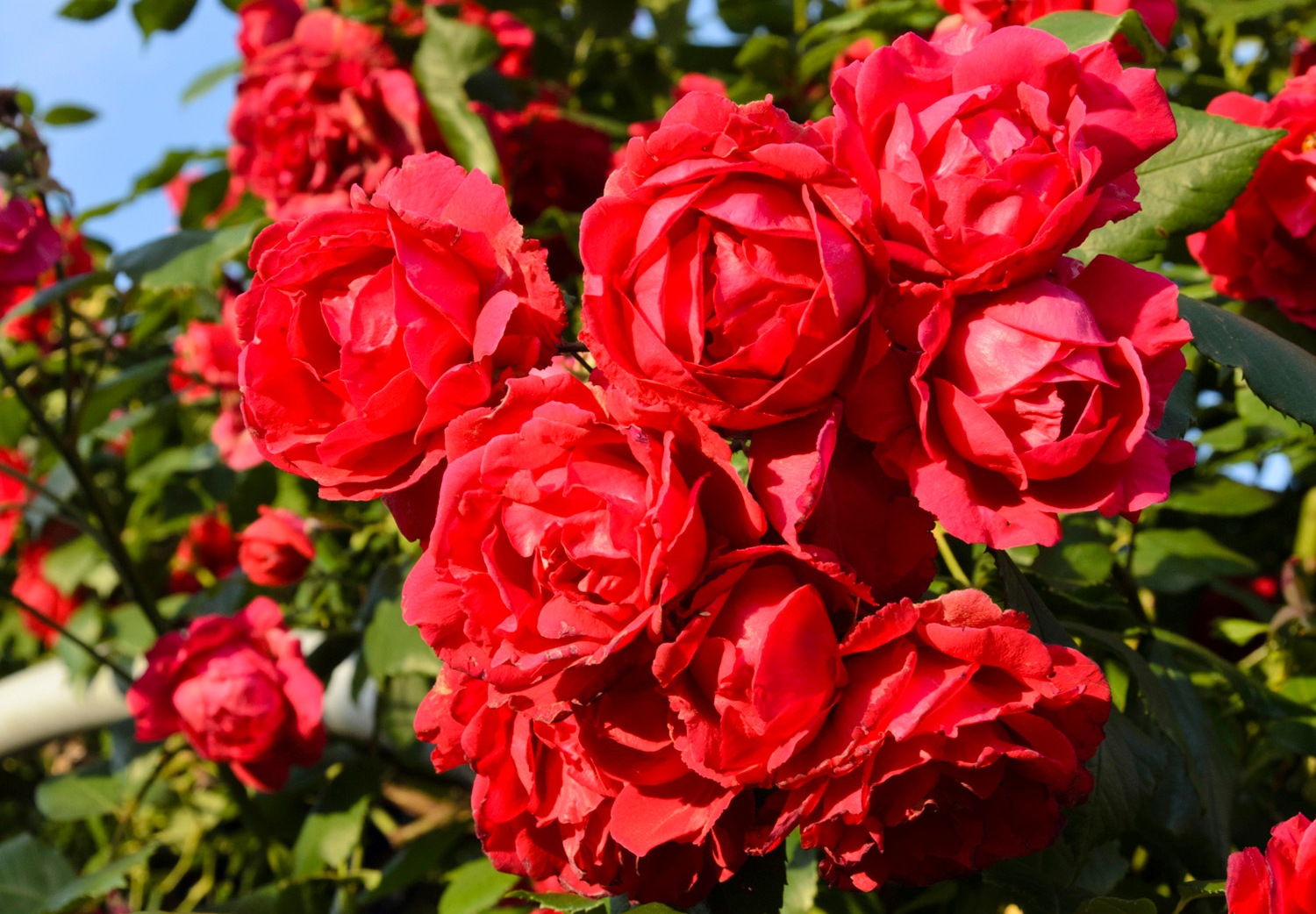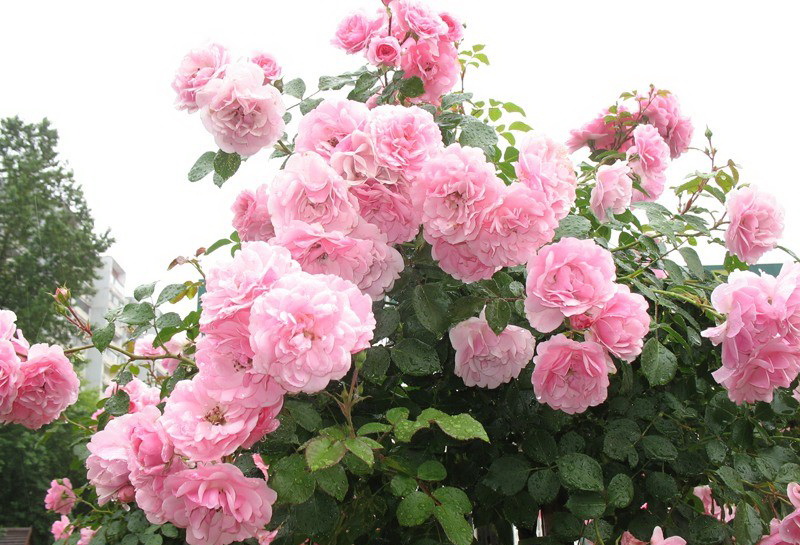Content:
Scarlett ground cover rose has been popular all over the world for over 100 years. Its obvious superiority is its dense bloom and pleasant honey-apple scent. The small size of the flowers compensates for their large number on the bush. Scarlet rose is most often used for vertical gardening, as it looks especially impressive in this form.
Origin history and variety description
Rose Scarlett took her first roots in the 1920s and 1930s. last century in Great Britain thanks to the famous breeder W. Paul, who took as a basis the hybrid of the Wichurana flower.
Rose Scarlet forms deep red buds, which eventually change to crimson, and by the end of flowering - cherry. A flower 6-7 cm in diameter has a semi-double structure and consists of 25 petals. Blooms in brushes, most often on last year's shoots. Flowers on young shoots of the current year rarely appear, and if they bloom, then they are much less in volume.
The variety has a strong immunity to diseases and easily withstands heavy rains. A distinctive feature is good winter hardiness, but this applies to a mild climate. In severe winters, a secure wrap is essential.
The flower is not particularly whimsical: it feels good in the sun and in partial shade. Unlike other climbing varieties, it takes root successfully on rich soil and sandy.
Features of ground cover roses and their characteristics
In general, ground cover varieties of roses have the following features:
- dense branching of stems, widely located on the site;
- rapid growth of stems;
- long lush bloom;
- stable immunity to pests, frosts, diseases;
- do not need pruning and time-consuming maintenance.
All this influenced the popularity of the rose, especially in countries with a harsh climate, where not all flowers are able to take root.
The following factors influence the correct and active growth:
- soil composition and slope;
- temperature;
- moisture and acidity of the soil;
- landing density.
Ground cover roses love light, which contributes to the abundant and long flowering of buds due to the fact that nutrients in the soil quickly penetrate into the plant, and moisture does not linger on the petals. Roses are suitable for a soil slope of about 8-10˚ to the west or southeast from the sunny side in the morning and with a shade at noon. If the flowers are under the scorching rays for a long time, the color of the buds will become pale, and they will quickly fall off.
Ground cover roses do not like moist soil, which blocks oxygen circulation and leads to hypothermia of the earth in winter. If the choice of another landing site is not possible, gravel should be poured into the landing pit. This will not fix the problem, but it will make growing easier.
With regard to the composition of the earth, loamy is favorable, which delivers oxygen and moisture well to the roots of the plant. Do not plant roses in sandy soil, which freezes in winter, heats up a lot in summer and practically does not retain nutrients. To improve the composition, you can add compost with peat, earth and clay.
The seedling hole should be prepared a couple of weeks before planting the flower in the open ground.
Before planting, leaves and buds growing below the graft are removed from the shoots. Broken and weak branches are cut off and the length of the roots is not more than 20-35 cm.The length of the stem above the ground should not exceed 35 cm.Before planting, the seedlings are disinfected with 5% copper sulfate, and the roots are dipped in a mixture of clay talker and mullein in a 2: 1 ratio.
When planting in spring, the shoots are cut so that a strong seedling has 2-3 buds, 1-2 is enough for a weak one.
Autumn planting is carried out from mid-September to the second decade of October. It is not recommended to do this later, as the roots may not have time to take root and freeze. It is enough to cut the shoots a little, since all the main manipulations are carried out in the spring.
Despite the fact that ground cover roses are unpretentious, for the correct and healthy formation of the bush, you will have to make a little effort in their pruning and periodic feeding with organic fertilizers.
Roses should be watered at least once a week with warm water and poured under the bush, and not on the branches. Depending on the size of the rose, no more than 15 liters of water will be needed. Young seedlings are watered more often for better rooting.
Frost resistance allows you not to wrap up the shoots. They are able to withstand cold weather under a snow cover.
Types of ground cover roses
Those interested in ground cover roses should pay attention to the following popular varieties:
- Scarlet Meillandecor rose differs from other species in that it grows quickly, is hardy and adapts well to any area. Its small buds of raspberry-red shades are beautifully combined with dark green leaves. Ground cover rose Scarlet Meyandecor has a small stem, which reaches 40 cm. The shape of the bush is fountain-shaped due to the fact that the shoots fall down under the weight of the buds. Rose Meillandecor blooms throughout the season. The aroma is delicate, but weakly expressed. The rose is frost and disease resistant.
- The Scarlet Meidiland rose is an excellent choice for landscaping. Maidiland has sprawling stems with bright red buds 3-4 cm in diameter. The size of the bush can be controlled by pruning, since its height reaches 1 m and its width is 1.5-2 m. Meidiland blooms throughout the summer almost without interruption. The best place to disembark is a sunny area. Rose Scarlet Meidiland is resistant to diseases and pests.
- Rose Bonica Scarlet has red double buds, consisting of 60-65 petals. Flower diameter 8 cm. Dark green glossy foliage resistant to diseases. Bonica Scarlett reaches a height of 40-70 cm. It blooms profusely throughout the season. In 2015, the variety became a hit and won gold and silver medals at flower shows in Italy and Belgium.
Advantages and disadvantages of the variety
The indisputable advantages of the variety include:
- unpretentiousness and resistance to diseases and pests;
- no need for annual pruning;
- after 2 years suppresses weeds;
- easily propagated by cuttings and layering.
The disadvantages include only poor frost tolerance in harsh regions, since young shoots do not have time to get stronger and are exposed to freezing, are affected by fungal diseases. That is why, after the first October frosts, the bush is cut off by 25 cm, unripe shoots are removed. The base of the bush spuds 15 cm, and when stable cold weather sets in, the shoots are collected in a bunch, laid on foam plastic and covered with roofing material or spruce branches on top.
If the florist has a desire to decorate the yard with extraordinary roses, he should not hesitate: whether or not to buy ground cover rose seedlings. A really unusual bush will grow to the envy of all neighbors!















